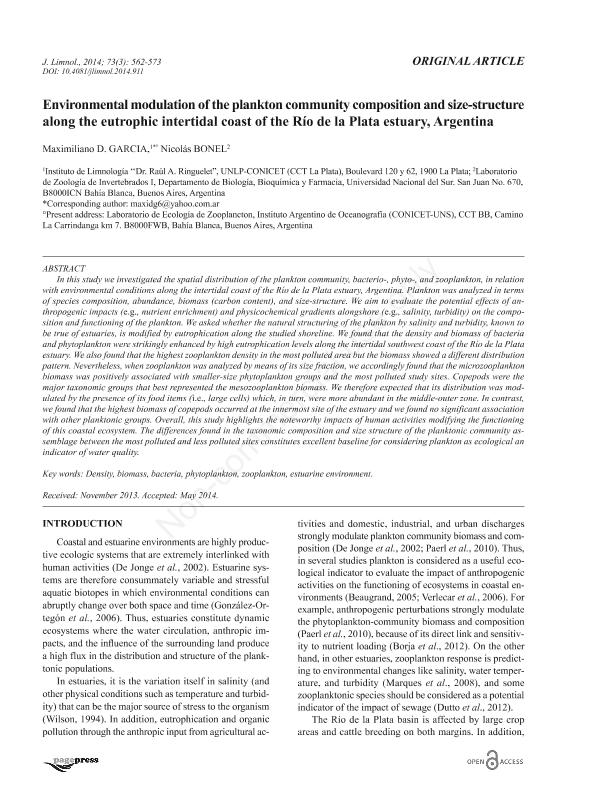Mostrar el registro sencillo del ítem
dc.contributor.author
Garcia, Maximiliano Darío

dc.contributor.author
Bonel, Nicolás

dc.date.available
2017-08-03T18:17:04Z
dc.date.issued
2014-05
dc.identifier.citation
Garcia, Maximiliano Darío; Bonel, Nicolás; Environmental modulation of the plankton community composition and size-structure along the eutrophic intertidal coast of the Río de la Plata estuary, Argentina; Page Press; Journal of Limnology; 73; 3; 5-2014; 562-573
dc.identifier.issn
1129-5767
dc.identifier.uri
http://hdl.handle.net/11336/21821
dc.description.abstract
In this study we investigated the spatial distribution of the plankton community, bacterio-, phyto-, and zooplankton, in relation with environmental conditions along the intertidal coast of the Río de la Plata estuary, Argentina. Plankton was analyzed in terms of species composition, abundance, biomass (carbon content), and size-structure. We aim to evaluate the potential effects of anthropogenic impacts (e.g., nutrient enrichment) and physicochemical gradients alongshore (e.g., salinity, turbidity) on the composition and functioning of the plankton. We asked whether the natural structuring of the plankton by salinity and turbidity, known to be true of estuaries, is modified by eutrophication along the studied shoreline. We found that the density and biomass of bacteria and phytoplankton were strikingly enhanced by high eutrophication levels along the intertidal southwest coast of the Río de la Plata estuary. We also found that the highest zooplankton density in the most polluted area but the biomass showed a different distribution pattern. Nevertheless, when zooplankton was analyzed by means of its size fraction, we accordingly found that the microzooplankton biomass was positively associated with smaller-size phytoplankton groups and the most polluted study sites. Copepods were the major taxonomic groups that best represented the mesozooplankton biomass. We therefore expected that its distribution was modulated by the presence of its food items (i.e., large cells) which, in turn, were more abundant in the middle-outer zone. In contrast, we found that the highest biomass of copepods occurred at the innermost site of the estuary and we found no significant association with other planktonic groups. Overall, this study highlights the noteworthy impacts of human activities modifying the functioning of this coastal ecosystem. The differences found in the taxonomic composition and size structure of the planktonic community assemblage between the most polluted and less polluted sites constitutes excellent baseline for considering plankton as ecological an indicator of water quality.
dc.format
application/pdf
dc.language.iso
eng
dc.publisher
Page Press
dc.rights
info:eu-repo/semantics/openAccess
dc.rights.uri
https://creativecommons.org/licenses/by-nc/2.5/ar/
dc.subject
Bacteria
dc.subject
Phytoplankton
dc.subject
Zooplankton
dc.subject
Estuarine Enviroment
dc.subject
Density
dc.subject
Biomass
dc.subject.classification
Bioquímica y Biología Molecular

dc.subject.classification
Ciencias Biológicas

dc.subject.classification
CIENCIAS NATURALES Y EXACTAS

dc.title
Environmental modulation of the plankton community composition and size-structure along the eutrophic intertidal coast of the Río de la Plata estuary, Argentina
dc.type
info:eu-repo/semantics/article
dc.type
info:ar-repo/semantics/artículo
dc.type
info:eu-repo/semantics/publishedVersion
dc.date.updated
2017-07-31T21:44:24Z
dc.identifier.eissn
1723-8633
dc.journal.volume
73
dc.journal.number
3
dc.journal.pagination
562-573
dc.journal.pais
Italia

dc.journal.ciudad
Pavia
dc.description.fil
Fil: Garcia, Maximiliano Darío. Consejo Nacional de Investigaciones Científicas y Técnicas. Centro Científico Tecnológico Conicet - Bahía Blanca. Instituto Argentino de Oceanografía. Universidad Nacional del Sur. Instituto Argentino de Oceanografía; Argentina. Universidad Nacional del Sur. Departamento de Biología, Bioquímica y Farmacia. Laboratorio de Zoología de Invertebrados I; Argentina. Consejo Nacional de Investigaciones Científicas y Técnicas. Centro Científico Tecnológico Conicet - Bahía Blanca. Instituto Argentino de Oceanografía. Universidad Nacional del Sur. Instituto Argentino de Oceanografía; Argentina
dc.description.fil
Fil: Bonel, Nicolás. Universidad Nacional del Sur. Departamento de Biología, Bioquímica y Farmacia. Laboratorio de Zoología de Invertebrados I; Argentina. Consejo Nacional de Investigaciones Científicas y Técnicas; Argentina
dc.journal.title
Journal of Limnology

dc.relation.alternativeid
info:eu-repo/semantics/altIdentifier/doi/http://dx.doi.org/10.4081/jlimnol.2014.911
dc.relation.alternativeid
info:eu-repo/semantics/altIdentifier/url/http://www.jlimnol.it/index.php/jlimnol/article/view/jlimnol.2014.911
Archivos asociados
